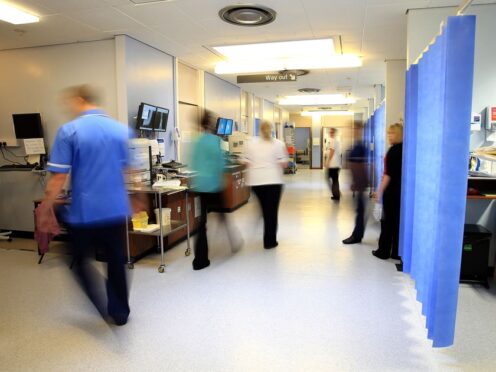
More than 250 patients a week may have died needlessly in England last year due to very long waits in A&E for a hospital bed, new estimates suggest.
Calculations by the Royal College of Emergency Medicine (RCEM) which have been shared with the PA news agency suggest patients are coming to harm due to spending hours in A&E, particularly after a decision has been made to admit them.
The NHS recovery plan set a target of March for 76% of patients attending A&E to be admitted, transferred or discharged within four hours.
But data for March shows just 70.9% of patients were seen within that time frame.
In February, the number of people waiting more than 12 hours in A&E departments from a decision to admit to actually being admitted stood at 44,417.
For its new excess death estimates, the RCEM used a very large study of more than five million NHS patients published in the Emergency Medicine Journal (EMJ) in 2021.
This found there was one excess death for every 72 patients that spent eight to 12 hours in an A&E department.
The risk of death started to increase after five hours and got worse with longer waiting times.
In 2022, the RCEM said it believed 300 to 500 excess deaths were likely to have occurred in England each week using this calculation, but it has since carried out a Freedom of Information audit of NHS trusts to refine this figure.
This found that 65% of people waiting 12 hours or more in A&E are patients waiting for a hospital bed.
NHS data for England shows more than 1.5 million patients waited 12 hours or more in major emergency departments in 2023, meaning over a million of those were waiting for a bed.
The RCEM has calculated that, when looking solely at patients awaiting admission, an average of 268 excess deaths are likely to have occurred each week in 2023, which is “only 17 fewer than 2022 when applying the same method”.
The college added that patients delayed in the back of ambulances, “of which there are thousands”, are not included in the figures but are also at risk of harm.
It said the overall estimates are likely to be conservative.
Dr Adrian Boyle, president of the RCEM, said: “Excessively long waits continue to put patients at risk of serious harm.
“Small improvements in four-hour access standard performance are not meaningful when there are so many people staying more than 12 hours.
“Effort and money should go where the harm is greatest.
“In 2023, more than 1.5 million patients waited 12 hours or more in major emergency departments, with 65% of those awaiting admission.
“Lack of hospital capacity means that patients are staying in longer than necessary and continue to be cared for by emergency department staff, often in clinically inappropriate areas such as corridors or ambulances.
“The direct correlation between delays and mortality rates is clear. Patients are being subjected to avoidable harm.
“Urgent intervention is needed to put people first. Patients and staff should not bear the consequences of insufficient funding and under-resourcing.
“We cannot continue to face inequalities in care, avoidable delays and death.”
An NHS spokesperson said: “We have seen significant increases in demand for A&E services, with attendances in February up 8.6% on last year and emergency admissions up 7.7%, and the latest published data shows our urgent and emergency care recovery plan – backed by extra funding with more beds, capacity and greater use of measures like same day emergency care – is delivering improvements, alongside continued work with our colleagues in community and social care to discharge patients when they are medically fit to go home, freeing up beds for other patients.
“The cause of excess deaths is down to several different factors and so it is right that the experts at the ONS – as the executive branch of the stats authority – continue to analyse these causes.”
A Department of Health and Social Care spokesperson said: “We are committed to ensuring people get the emergency care they need, when they need it, and all patients attending A&E are assessed by a doctor or nurse before any treatment takes place, to ensure the most seriously unwell people are treated first.
“Thanks to our £200 million urgent care recovery plan, A&E four-hour performance improved in February compared to January, despite the highest number of February A&E attendances on record and the impact of industrial action.
“We are determined to continue improving experiences for patients and making access to care faster, simpler and fairer.
“We are making progress in reducing A&E waiting times, including adding an extra 5,000 permanent staffed beds this winter to increase capacity and help patients be seen as quickly as possible.”
Royal College of Nursing general secretary Pat Cullen said “too few staff and not enough beds” were driving long waiting times.
“This crisis is taking lives and nursing staff in England’s hospitals are forced to witness it every shift,” she said.
“Go into any hospital, the corridors and cupboards are packed with patients – care is not only undignified but fatally unsafe.”
Shadow health secretary Wes Streeting said: “Rishi Sunak has failed to get patients seen on time in A&E, and patients are suffering tragically as a result.
“The chaos in the NHS will only get worse with another five years of the Conservatives. The longer the Conservatives are in office, the longer patients will wait.
“When Labour was last in government, patients were seen on time in A&E. We did it before and we will do it again.”

Enjoy the convenience of having The Sunday Post delivered as a digital ePaper straight to your smartphone, tablet or computer.
Subscribe for only £5.49 a month and enjoy all the benefits of the printed paper as a digital replica.
Subscribe